ENST20001: Contextual & Attitudinal Factors in Solar Panel Usage
VerifiedAdded on 2023/03/21
|15
|3313
|52
Report
AI Summary
This report explores the influence of contextual and attitudinal factors on solar panel usage for household electricity in Australia, targeting residents outside metropolitan areas. Using telephonic interviews and thematic coding for data analysis, the study identifies that while attitudes towards solar panels are generally positive, negative contextual factors like high installation and maintenance costs significantly hinder adoption. The research, based on Stern's Attitude-Behavior-Context model, reveals that peer opinions and awareness campaigns are major positive influences, while cost-effectiveness and environmental friendliness are key attitudinal drivers. The findings support the theory that contextual factors significantly impact behavior, even in the presence of positive attitudes, suggesting that addressing cost barriers could promote greater solar panel adoption.
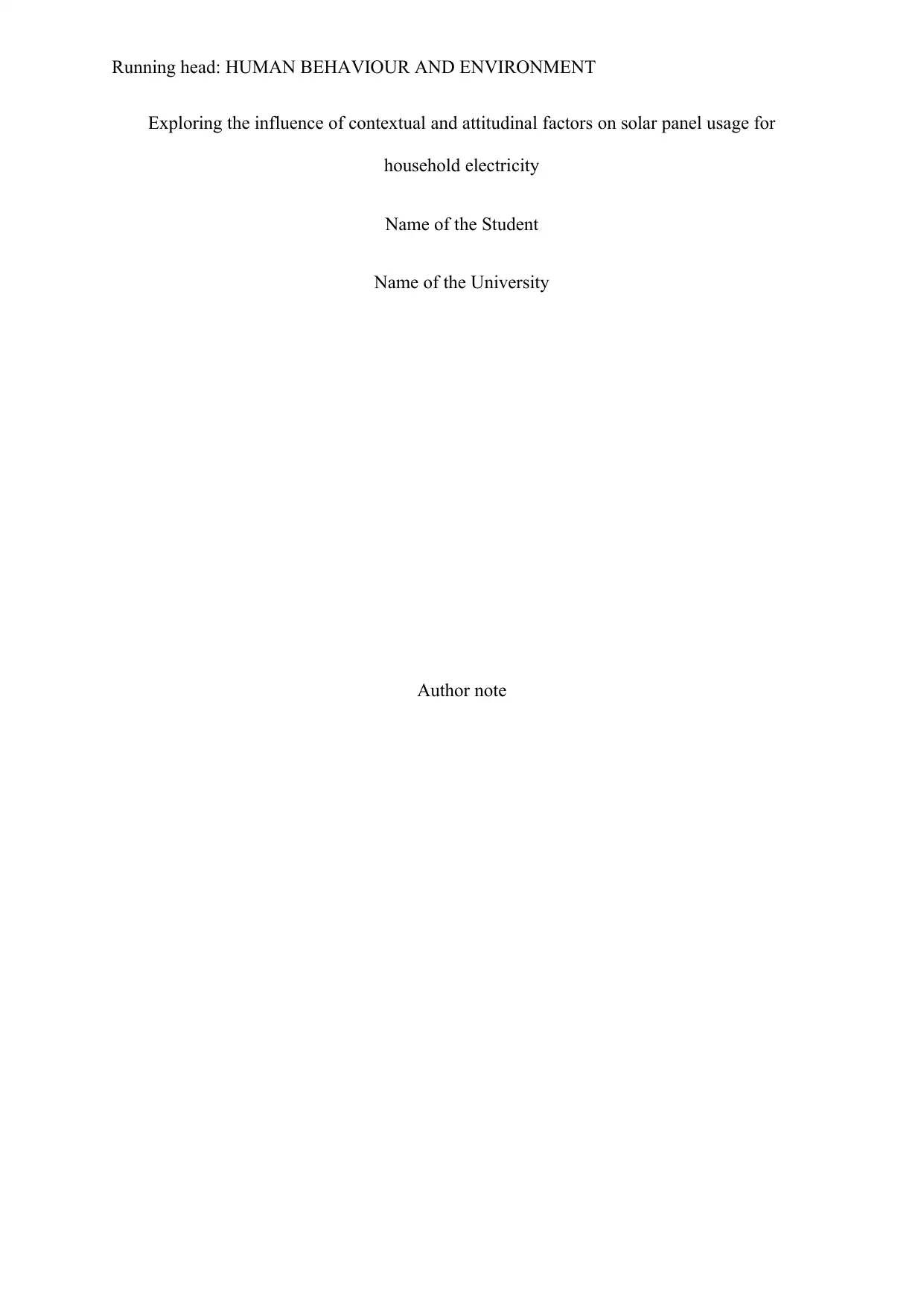
Running head: HUMAN BEHAVIOUR AND ENVIRONMENT
Exploring the influence of contextual and attitudinal factors on solar panel usage for
household electricity
Name of the Student
Name of the University
Author note
Exploring the influence of contextual and attitudinal factors on solar panel usage for
household electricity
Name of the Student
Name of the University
Author note
Paraphrase This Document
Need a fresh take? Get an instant paraphrase of this document with our AI Paraphraser
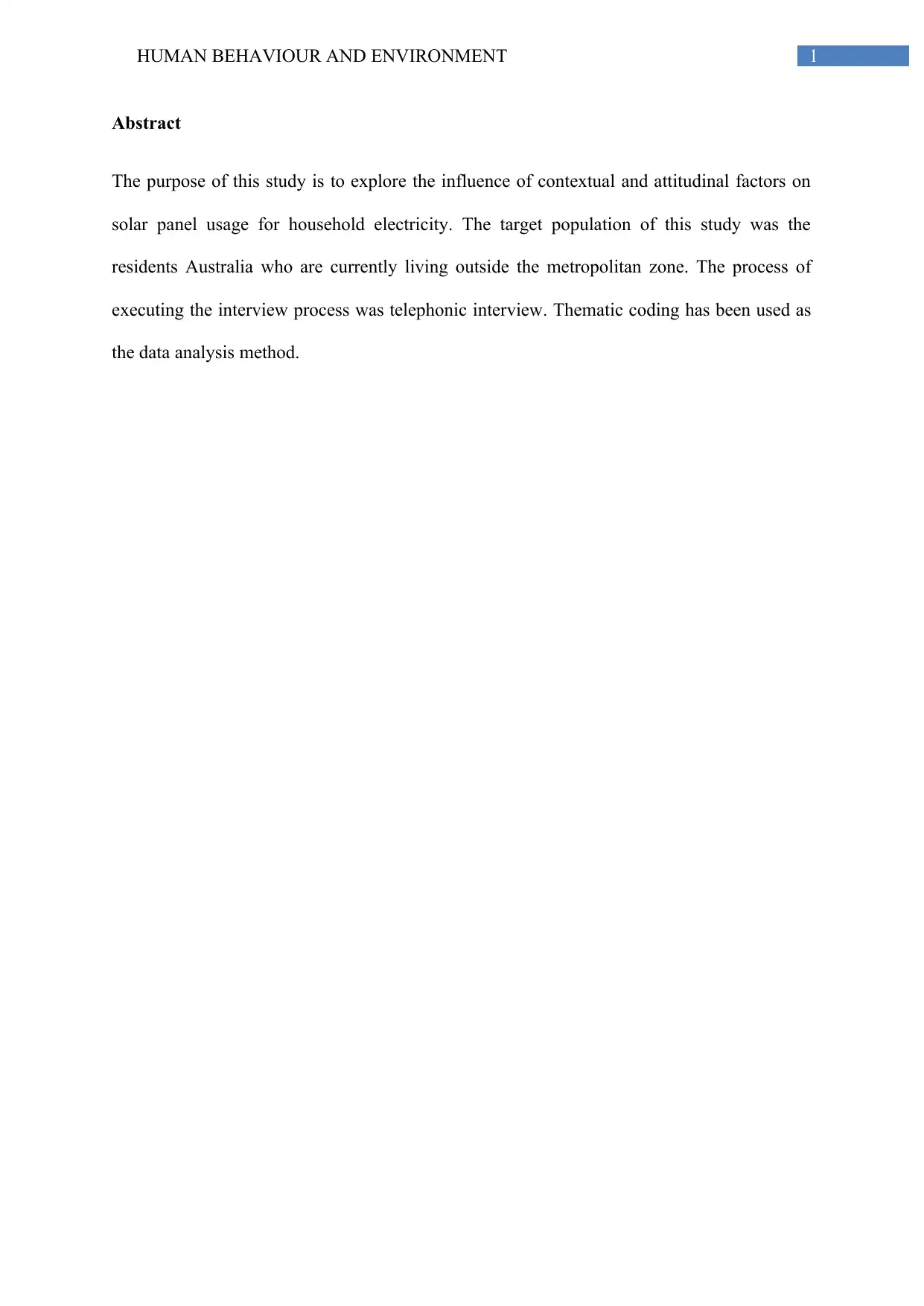
1HUMAN BEHAVIOUR AND ENVIRONMENT
Abstract
The purpose of this study is to explore the influence of contextual and attitudinal factors on
solar panel usage for household electricity. The target population of this study was the
residents Australia who are currently living outside the metropolitan zone. The process of
executing the interview process was telephonic interview. Thematic coding has been used as
the data analysis method.
Abstract
The purpose of this study is to explore the influence of contextual and attitudinal factors on
solar panel usage for household electricity. The target population of this study was the
residents Australia who are currently living outside the metropolitan zone. The process of
executing the interview process was telephonic interview. Thematic coding has been used as
the data analysis method.
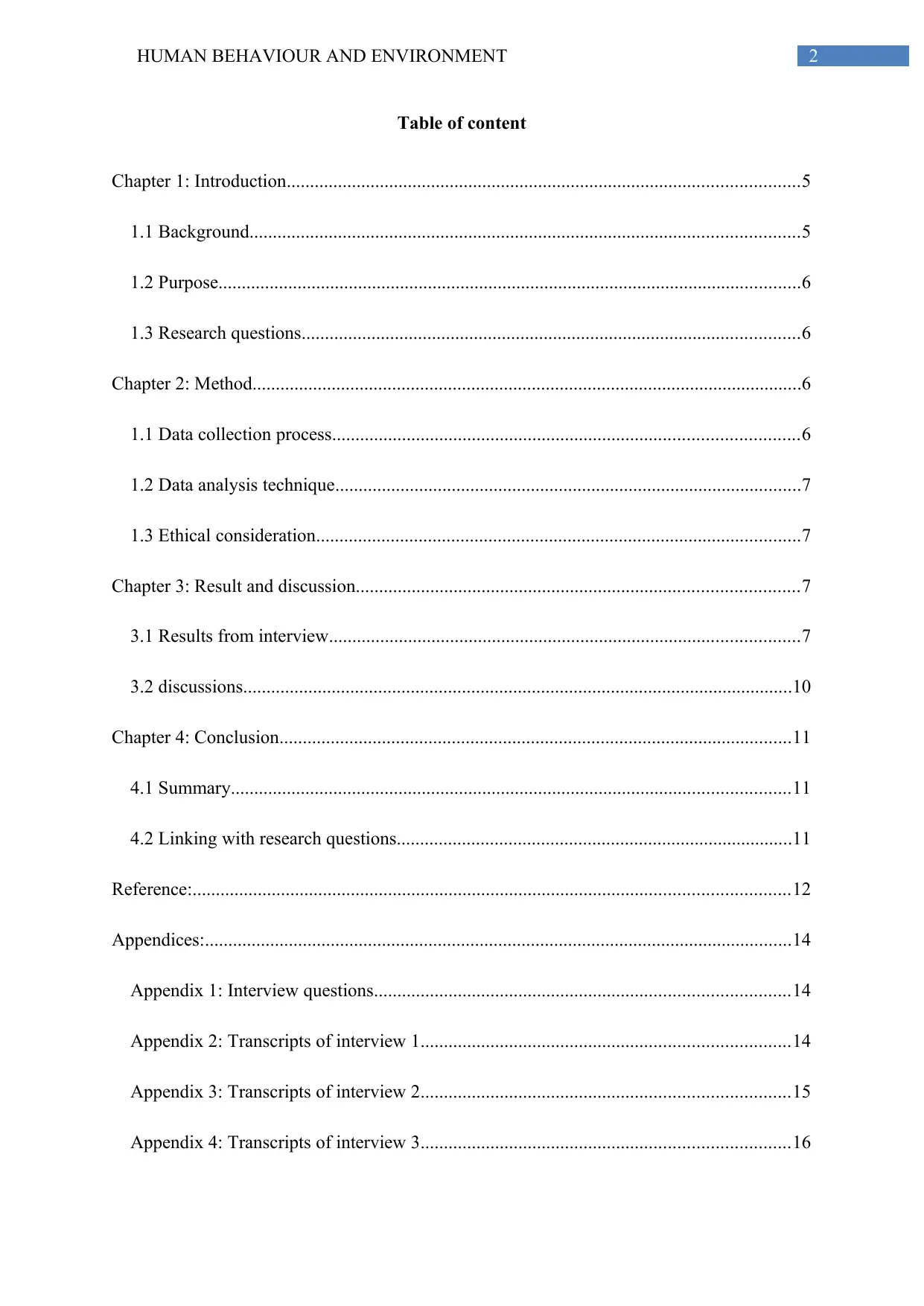
2HUMAN BEHAVIOUR AND ENVIRONMENT
Table of content
Chapter 1: Introduction..............................................................................................................5
1.1 Background......................................................................................................................5
1.2 Purpose.............................................................................................................................6
1.3 Research questions...........................................................................................................6
Chapter 2: Method......................................................................................................................6
1.1 Data collection process....................................................................................................6
1.2 Data analysis technique....................................................................................................7
1.3 Ethical consideration........................................................................................................7
Chapter 3: Result and discussion...............................................................................................7
3.1 Results from interview.....................................................................................................7
3.2 discussions......................................................................................................................10
Chapter 4: Conclusion..............................................................................................................11
4.1 Summary........................................................................................................................11
4.2 Linking with research questions.....................................................................................11
Reference:................................................................................................................................12
Appendices:..............................................................................................................................14
Appendix 1: Interview questions.........................................................................................14
Appendix 2: Transcripts of interview 1...............................................................................14
Appendix 3: Transcripts of interview 2...............................................................................15
Appendix 4: Transcripts of interview 3...............................................................................16
Table of content
Chapter 1: Introduction..............................................................................................................5
1.1 Background......................................................................................................................5
1.2 Purpose.............................................................................................................................6
1.3 Research questions...........................................................................................................6
Chapter 2: Method......................................................................................................................6
1.1 Data collection process....................................................................................................6
1.2 Data analysis technique....................................................................................................7
1.3 Ethical consideration........................................................................................................7
Chapter 3: Result and discussion...............................................................................................7
3.1 Results from interview.....................................................................................................7
3.2 discussions......................................................................................................................10
Chapter 4: Conclusion..............................................................................................................11
4.1 Summary........................................................................................................................11
4.2 Linking with research questions.....................................................................................11
Reference:................................................................................................................................12
Appendices:..............................................................................................................................14
Appendix 1: Interview questions.........................................................................................14
Appendix 2: Transcripts of interview 1...............................................................................14
Appendix 3: Transcripts of interview 2...............................................................................15
Appendix 4: Transcripts of interview 3...............................................................................16
⊘ This is a preview!⊘
Do you want full access?
Subscribe today to unlock all pages.

Trusted by 1+ million students worldwide
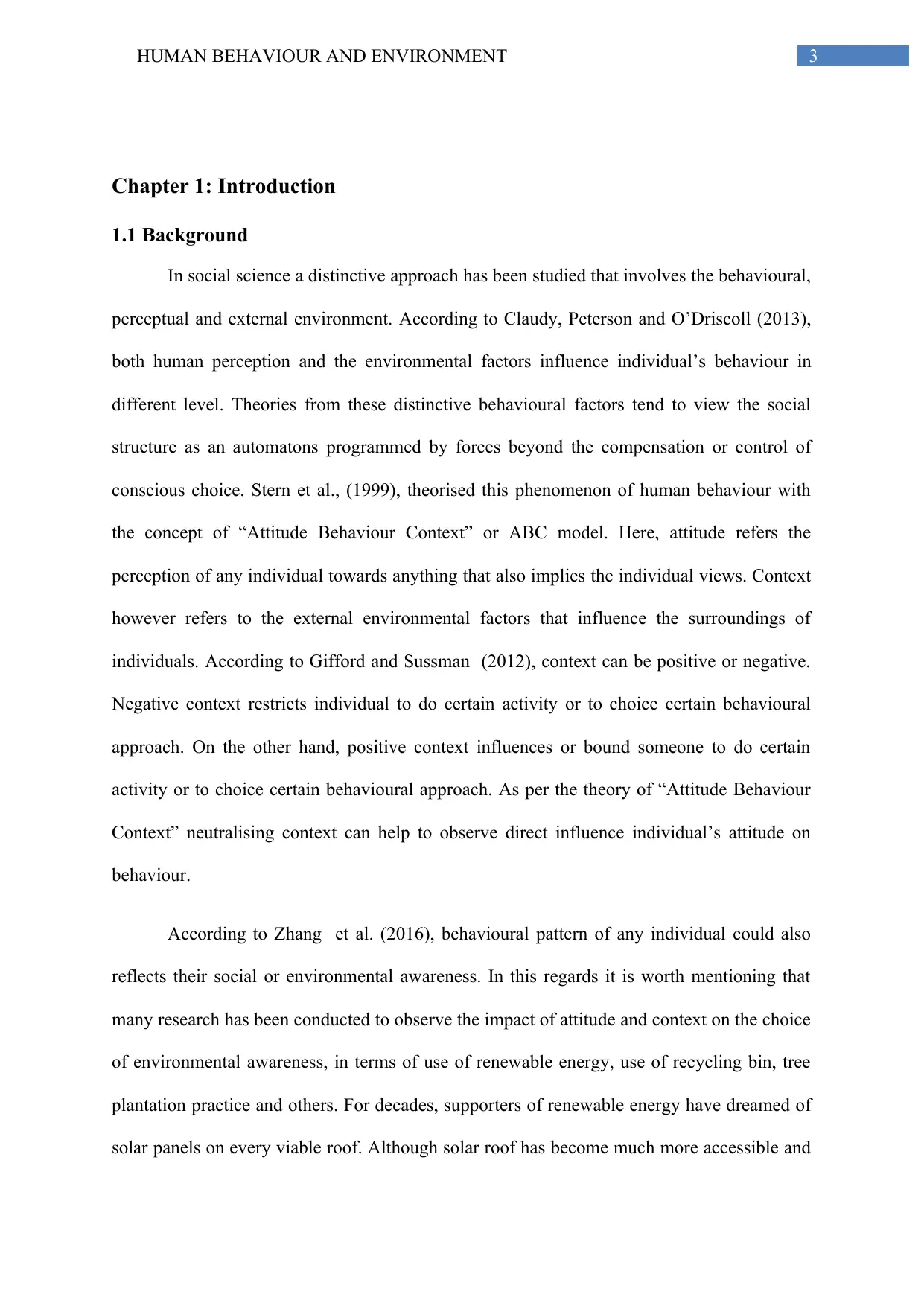
3HUMAN BEHAVIOUR AND ENVIRONMENT
Chapter 1: Introduction
1.1 Background
In social science a distinctive approach has been studied that involves the behavioural,
perceptual and external environment. According to Claudy, Peterson and O’Driscoll (2013),
both human perception and the environmental factors influence individual’s behaviour in
different level. Theories from these distinctive behavioural factors tend to view the social
structure as an automatons programmed by forces beyond the compensation or control of
conscious choice. Stern et al., (1999), theorised this phenomenon of human behaviour with
the concept of “Attitude Behaviour Context” or ABC model. Here, attitude refers the
perception of any individual towards anything that also implies the individual views. Context
however refers to the external environmental factors that influence the surroundings of
individuals. According to Gifford and Sussman (2012), context can be positive or negative.
Negative context restricts individual to do certain activity or to choice certain behavioural
approach. On the other hand, positive context influences or bound someone to do certain
activity or to choice certain behavioural approach. As per the theory of “Attitude Behaviour
Context” neutralising context can help to observe direct influence individual’s attitude on
behaviour.
According to Zhang et al. (2016), behavioural pattern of any individual could also
reflects their social or environmental awareness. In this regards it is worth mentioning that
many research has been conducted to observe the impact of attitude and context on the choice
of environmental awareness, in terms of use of renewable energy, use of recycling bin, tree
plantation practice and others. For decades, supporters of renewable energy have dreamed of
solar panels on every viable roof. Although solar roof has become much more accessible and
Chapter 1: Introduction
1.1 Background
In social science a distinctive approach has been studied that involves the behavioural,
perceptual and external environment. According to Claudy, Peterson and O’Driscoll (2013),
both human perception and the environmental factors influence individual’s behaviour in
different level. Theories from these distinctive behavioural factors tend to view the social
structure as an automatons programmed by forces beyond the compensation or control of
conscious choice. Stern et al., (1999), theorised this phenomenon of human behaviour with
the concept of “Attitude Behaviour Context” or ABC model. Here, attitude refers the
perception of any individual towards anything that also implies the individual views. Context
however refers to the external environmental factors that influence the surroundings of
individuals. According to Gifford and Sussman (2012), context can be positive or negative.
Negative context restricts individual to do certain activity or to choice certain behavioural
approach. On the other hand, positive context influences or bound someone to do certain
activity or to choice certain behavioural approach. As per the theory of “Attitude Behaviour
Context” neutralising context can help to observe direct influence individual’s attitude on
behaviour.
According to Zhang et al. (2016), behavioural pattern of any individual could also
reflects their social or environmental awareness. In this regards it is worth mentioning that
many research has been conducted to observe the impact of attitude and context on the choice
of environmental awareness, in terms of use of renewable energy, use of recycling bin, tree
plantation practice and others. For decades, supporters of renewable energy have dreamed of
solar panels on every viable roof. Although solar roof has become much more accessible and
Paraphrase This Document
Need a fresh take? Get an instant paraphrase of this document with our AI Paraphraser
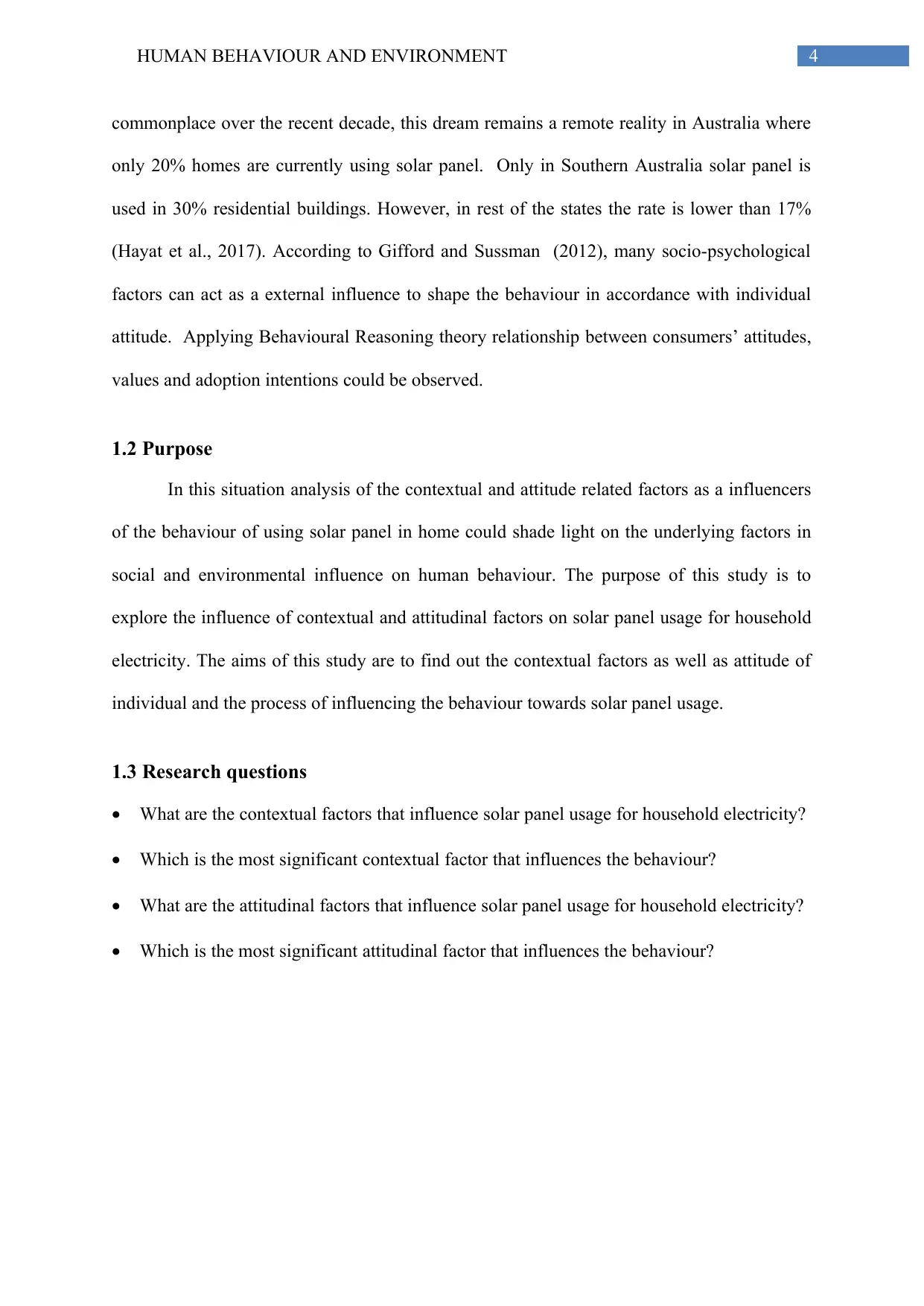
4HUMAN BEHAVIOUR AND ENVIRONMENT
commonplace over the recent decade, this dream remains a remote reality in Australia where
only 20% homes are currently using solar panel. Only in Southern Australia solar panel is
used in 30% residential buildings. However, in rest of the states the rate is lower than 17%
(Hayat et al., 2017). According to Gifford and Sussman (2012), many socio-psychological
factors can act as a external influence to shape the behaviour in accordance with individual
attitude. Applying Behavioural Reasoning theory relationship between consumers’ attitudes,
values and adoption intentions could be observed.
1.2 Purpose
In this situation analysis of the contextual and attitude related factors as a influencers
of the behaviour of using solar panel in home could shade light on the underlying factors in
social and environmental influence on human behaviour. The purpose of this study is to
explore the influence of contextual and attitudinal factors on solar panel usage for household
electricity. The aims of this study are to find out the contextual factors as well as attitude of
individual and the process of influencing the behaviour towards solar panel usage.
1.3 Research questions
What are the contextual factors that influence solar panel usage for household electricity?
Which is the most significant contextual factor that influences the behaviour?
What are the attitudinal factors that influence solar panel usage for household electricity?
Which is the most significant attitudinal factor that influences the behaviour?
commonplace over the recent decade, this dream remains a remote reality in Australia where
only 20% homes are currently using solar panel. Only in Southern Australia solar panel is
used in 30% residential buildings. However, in rest of the states the rate is lower than 17%
(Hayat et al., 2017). According to Gifford and Sussman (2012), many socio-psychological
factors can act as a external influence to shape the behaviour in accordance with individual
attitude. Applying Behavioural Reasoning theory relationship between consumers’ attitudes,
values and adoption intentions could be observed.
1.2 Purpose
In this situation analysis of the contextual and attitude related factors as a influencers
of the behaviour of using solar panel in home could shade light on the underlying factors in
social and environmental influence on human behaviour. The purpose of this study is to
explore the influence of contextual and attitudinal factors on solar panel usage for household
electricity. The aims of this study are to find out the contextual factors as well as attitude of
individual and the process of influencing the behaviour towards solar panel usage.
1.3 Research questions
What are the contextual factors that influence solar panel usage for household electricity?
Which is the most significant contextual factor that influences the behaviour?
What are the attitudinal factors that influence solar panel usage for household electricity?
Which is the most significant attitudinal factor that influences the behaviour?
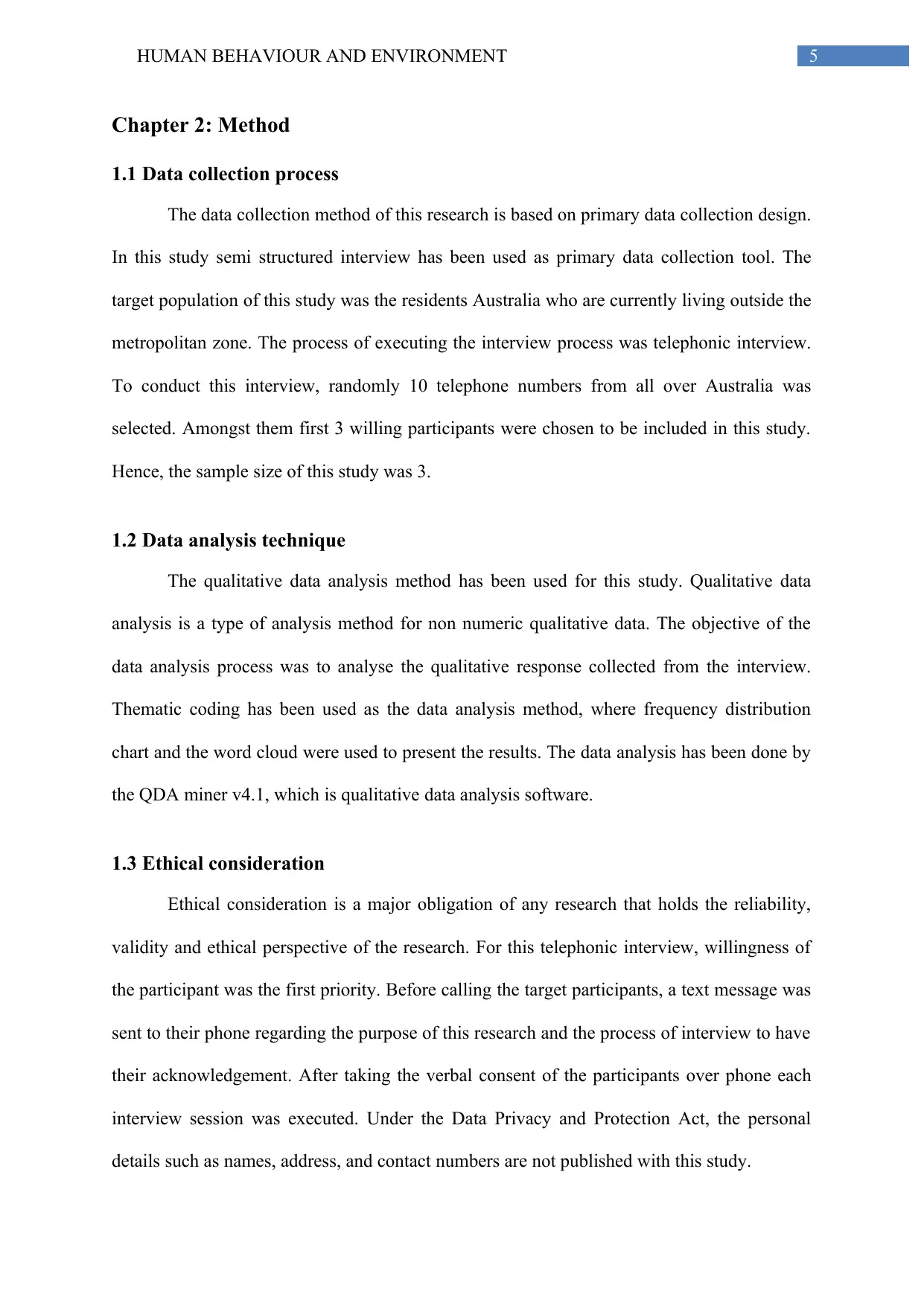
5HUMAN BEHAVIOUR AND ENVIRONMENT
Chapter 2: Method
1.1 Data collection process
The data collection method of this research is based on primary data collection design.
In this study semi structured interview has been used as primary data collection tool. The
target population of this study was the residents Australia who are currently living outside the
metropolitan zone. The process of executing the interview process was telephonic interview.
To conduct this interview, randomly 10 telephone numbers from all over Australia was
selected. Amongst them first 3 willing participants were chosen to be included in this study.
Hence, the sample size of this study was 3.
1.2 Data analysis technique
The qualitative data analysis method has been used for this study. Qualitative data
analysis is a type of analysis method for non numeric qualitative data. The objective of the
data analysis process was to analyse the qualitative response collected from the interview.
Thematic coding has been used as the data analysis method, where frequency distribution
chart and the word cloud were used to present the results. The data analysis has been done by
the QDA miner v4.1, which is qualitative data analysis software.
1.3 Ethical consideration
Ethical consideration is a major obligation of any research that holds the reliability,
validity and ethical perspective of the research. For this telephonic interview, willingness of
the participant was the first priority. Before calling the target participants, a text message was
sent to their phone regarding the purpose of this research and the process of interview to have
their acknowledgement. After taking the verbal consent of the participants over phone each
interview session was executed. Under the Data Privacy and Protection Act, the personal
details such as names, address, and contact numbers are not published with this study.
Chapter 2: Method
1.1 Data collection process
The data collection method of this research is based on primary data collection design.
In this study semi structured interview has been used as primary data collection tool. The
target population of this study was the residents Australia who are currently living outside the
metropolitan zone. The process of executing the interview process was telephonic interview.
To conduct this interview, randomly 10 telephone numbers from all over Australia was
selected. Amongst them first 3 willing participants were chosen to be included in this study.
Hence, the sample size of this study was 3.
1.2 Data analysis technique
The qualitative data analysis method has been used for this study. Qualitative data
analysis is a type of analysis method for non numeric qualitative data. The objective of the
data analysis process was to analyse the qualitative response collected from the interview.
Thematic coding has been used as the data analysis method, where frequency distribution
chart and the word cloud were used to present the results. The data analysis has been done by
the QDA miner v4.1, which is qualitative data analysis software.
1.3 Ethical consideration
Ethical consideration is a major obligation of any research that holds the reliability,
validity and ethical perspective of the research. For this telephonic interview, willingness of
the participant was the first priority. Before calling the target participants, a text message was
sent to their phone regarding the purpose of this research and the process of interview to have
their acknowledgement. After taking the verbal consent of the participants over phone each
interview session was executed. Under the Data Privacy and Protection Act, the personal
details such as names, address, and contact numbers are not published with this study.
⊘ This is a preview!⊘
Do you want full access?
Subscribe today to unlock all pages.

Trusted by 1+ million students worldwide
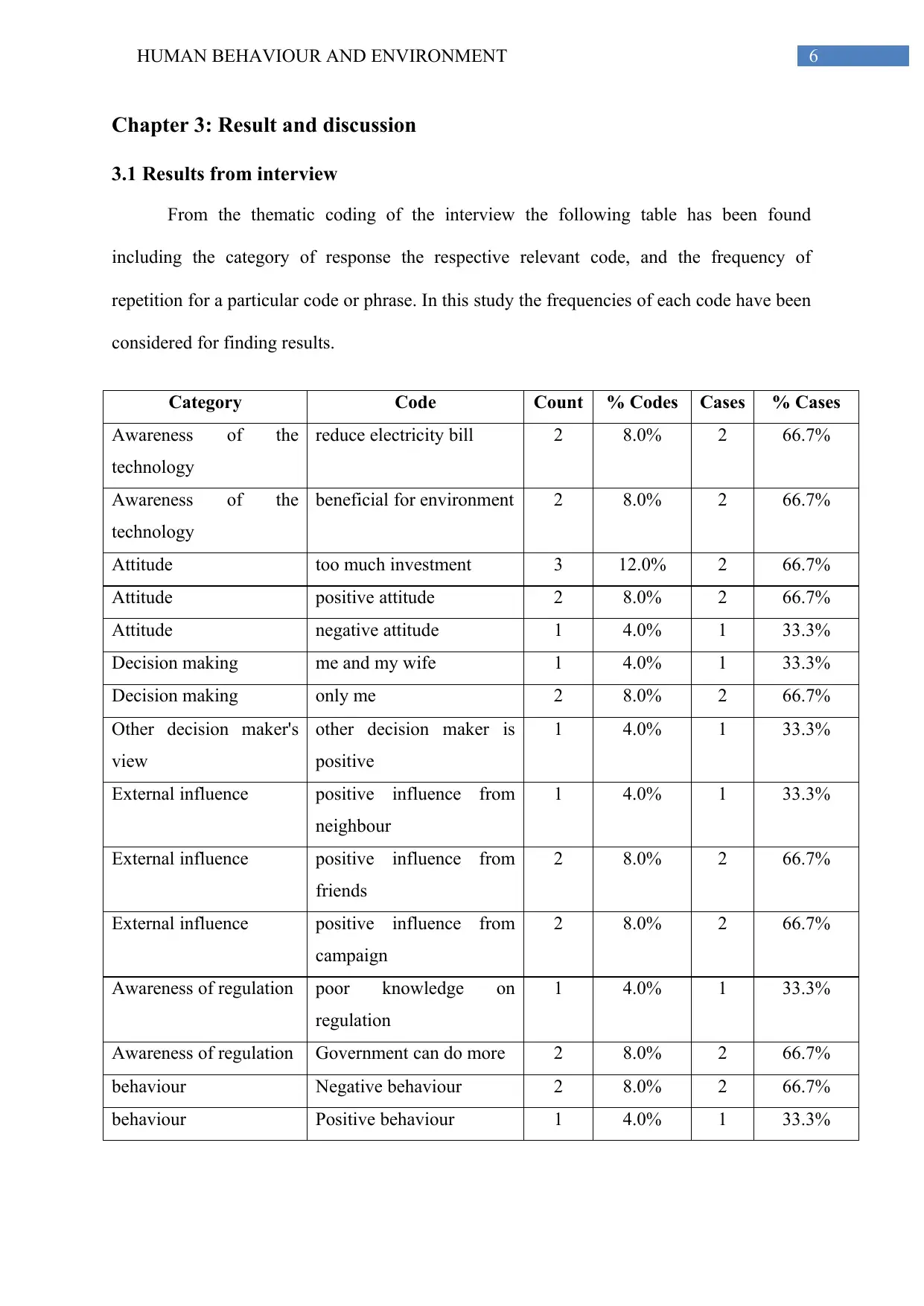
6HUMAN BEHAVIOUR AND ENVIRONMENT
Chapter 3: Result and discussion
3.1 Results from interview
From the thematic coding of the interview the following table has been found
including the category of response the respective relevant code, and the frequency of
repetition for a particular code or phrase. In this study the frequencies of each code have been
considered for finding results.
Category Code Count % Codes Cases % Cases
Awareness of the
technology
reduce electricity bill 2 8.0% 2 66.7%
Awareness of the
technology
beneficial for environment 2 8.0% 2 66.7%
Attitude too much investment 3 12.0% 2 66.7%
Attitude positive attitude 2 8.0% 2 66.7%
Attitude negative attitude 1 4.0% 1 33.3%
Decision making me and my wife 1 4.0% 1 33.3%
Decision making only me 2 8.0% 2 66.7%
Other decision maker's
view
other decision maker is
positive
1 4.0% 1 33.3%
External influence positive influence from
neighbour
1 4.0% 1 33.3%
External influence positive influence from
friends
2 8.0% 2 66.7%
External influence positive influence from
campaign
2 8.0% 2 66.7%
Awareness of regulation poor knowledge on
regulation
1 4.0% 1 33.3%
Awareness of regulation Government can do more 2 8.0% 2 66.7%
behaviour Negative behaviour 2 8.0% 2 66.7%
behaviour Positive behaviour 1 4.0% 1 33.3%
Chapter 3: Result and discussion
3.1 Results from interview
From the thematic coding of the interview the following table has been found
including the category of response the respective relevant code, and the frequency of
repetition for a particular code or phrase. In this study the frequencies of each code have been
considered for finding results.
Category Code Count % Codes Cases % Cases
Awareness of the
technology
reduce electricity bill 2 8.0% 2 66.7%
Awareness of the
technology
beneficial for environment 2 8.0% 2 66.7%
Attitude too much investment 3 12.0% 2 66.7%
Attitude positive attitude 2 8.0% 2 66.7%
Attitude negative attitude 1 4.0% 1 33.3%
Decision making me and my wife 1 4.0% 1 33.3%
Decision making only me 2 8.0% 2 66.7%
Other decision maker's
view
other decision maker is
positive
1 4.0% 1 33.3%
External influence positive influence from
neighbour
1 4.0% 1 33.3%
External influence positive influence from
friends
2 8.0% 2 66.7%
External influence positive influence from
campaign
2 8.0% 2 66.7%
Awareness of regulation poor knowledge on
regulation
1 4.0% 1 33.3%
Awareness of regulation Government can do more 2 8.0% 2 66.7%
behaviour Negative behaviour 2 8.0% 2 66.7%
behaviour Positive behaviour 1 4.0% 1 33.3%
Paraphrase This Document
Need a fresh take? Get an instant paraphrase of this document with our AI Paraphraser
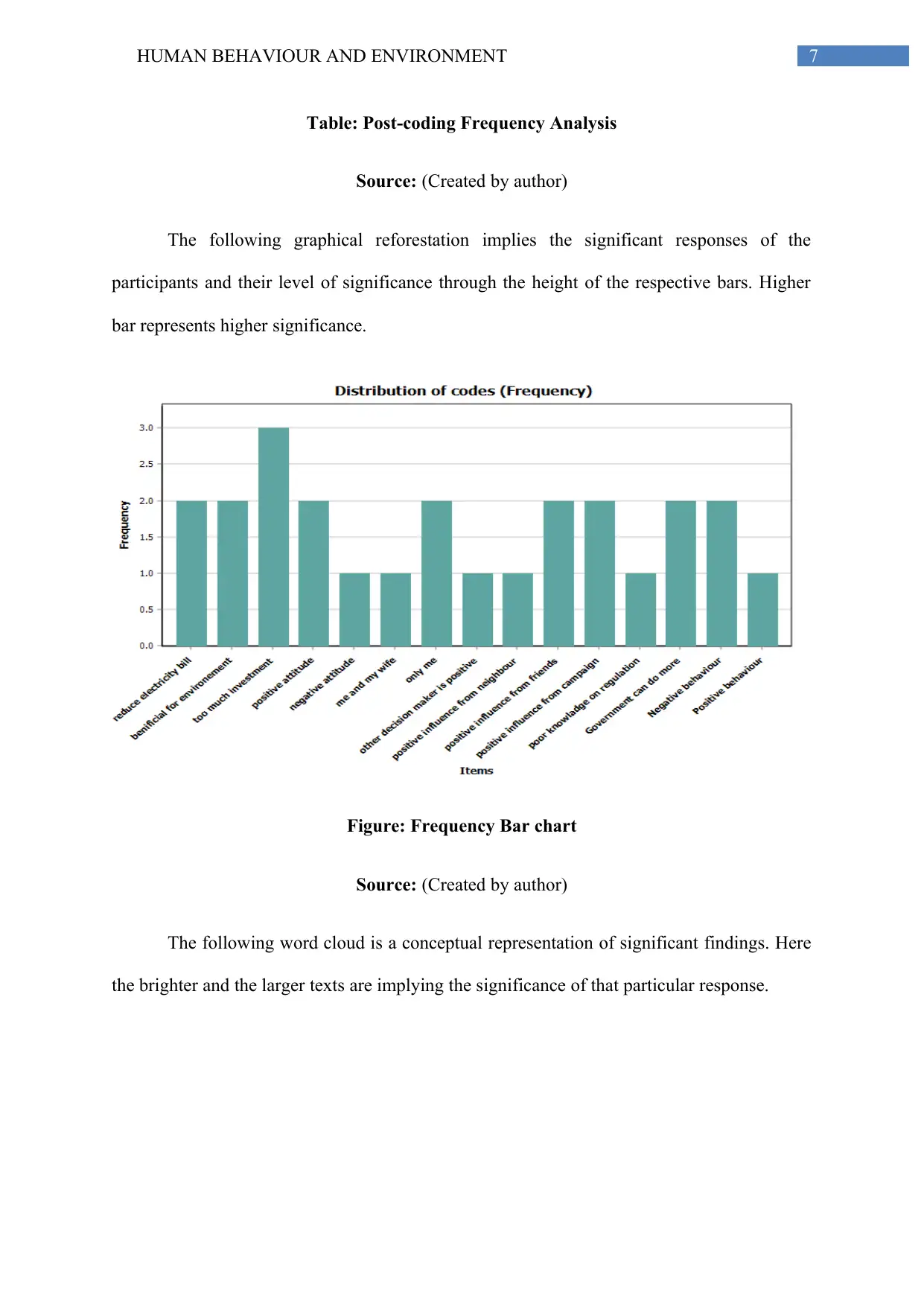
7HUMAN BEHAVIOUR AND ENVIRONMENT
Table: Post-coding Frequency Analysis
Source: (Created by author)
The following graphical reforestation implies the significant responses of the
participants and their level of significance through the height of the respective bars. Higher
bar represents higher significance.
Figure: Frequency Bar chart
Source: (Created by author)
The following word cloud is a conceptual representation of significant findings. Here
the brighter and the larger texts are implying the significance of that particular response.
Table: Post-coding Frequency Analysis
Source: (Created by author)
The following graphical reforestation implies the significant responses of the
participants and their level of significance through the height of the respective bars. Higher
bar represents higher significance.
Figure: Frequency Bar chart
Source: (Created by author)
The following word cloud is a conceptual representation of significant findings. Here
the brighter and the larger texts are implying the significance of that particular response.
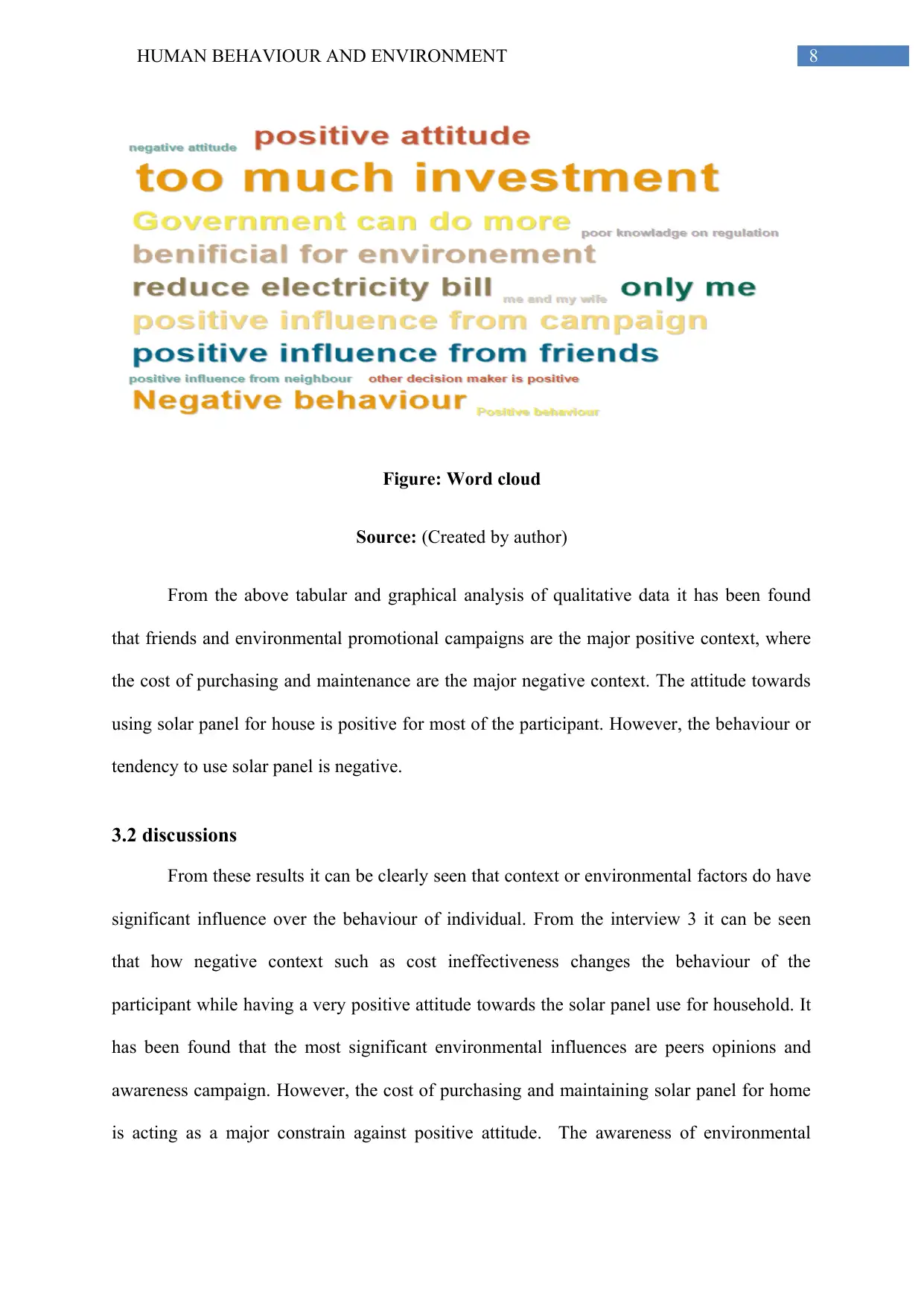
8HUMAN BEHAVIOUR AND ENVIRONMENT
Figure: Word cloud
Source: (Created by author)
From the above tabular and graphical analysis of qualitative data it has been found
that friends and environmental promotional campaigns are the major positive context, where
the cost of purchasing and maintenance are the major negative context. The attitude towards
using solar panel for house is positive for most of the participant. However, the behaviour or
tendency to use solar panel is negative.
3.2 discussions
From these results it can be clearly seen that context or environmental factors do have
significant influence over the behaviour of individual. From the interview 3 it can be seen
that how negative context such as cost ineffectiveness changes the behaviour of the
participant while having a very positive attitude towards the solar panel use for household. It
has been found that the most significant environmental influences are peers opinions and
awareness campaign. However, the cost of purchasing and maintaining solar panel for home
is acting as a major constrain against positive attitude. The awareness of environmental
Figure: Word cloud
Source: (Created by author)
From the above tabular and graphical analysis of qualitative data it has been found
that friends and environmental promotional campaigns are the major positive context, where
the cost of purchasing and maintenance are the major negative context. The attitude towards
using solar panel for house is positive for most of the participant. However, the behaviour or
tendency to use solar panel is negative.
3.2 discussions
From these results it can be clearly seen that context or environmental factors do have
significant influence over the behaviour of individual. From the interview 3 it can be seen
that how negative context such as cost ineffectiveness changes the behaviour of the
participant while having a very positive attitude towards the solar panel use for household. It
has been found that the most significant environmental influences are peers opinions and
awareness campaign. However, the cost of purchasing and maintaining solar panel for home
is acting as a major constrain against positive attitude. The awareness of environmental
⊘ This is a preview!⊘
Do you want full access?
Subscribe today to unlock all pages.

Trusted by 1+ million students worldwide
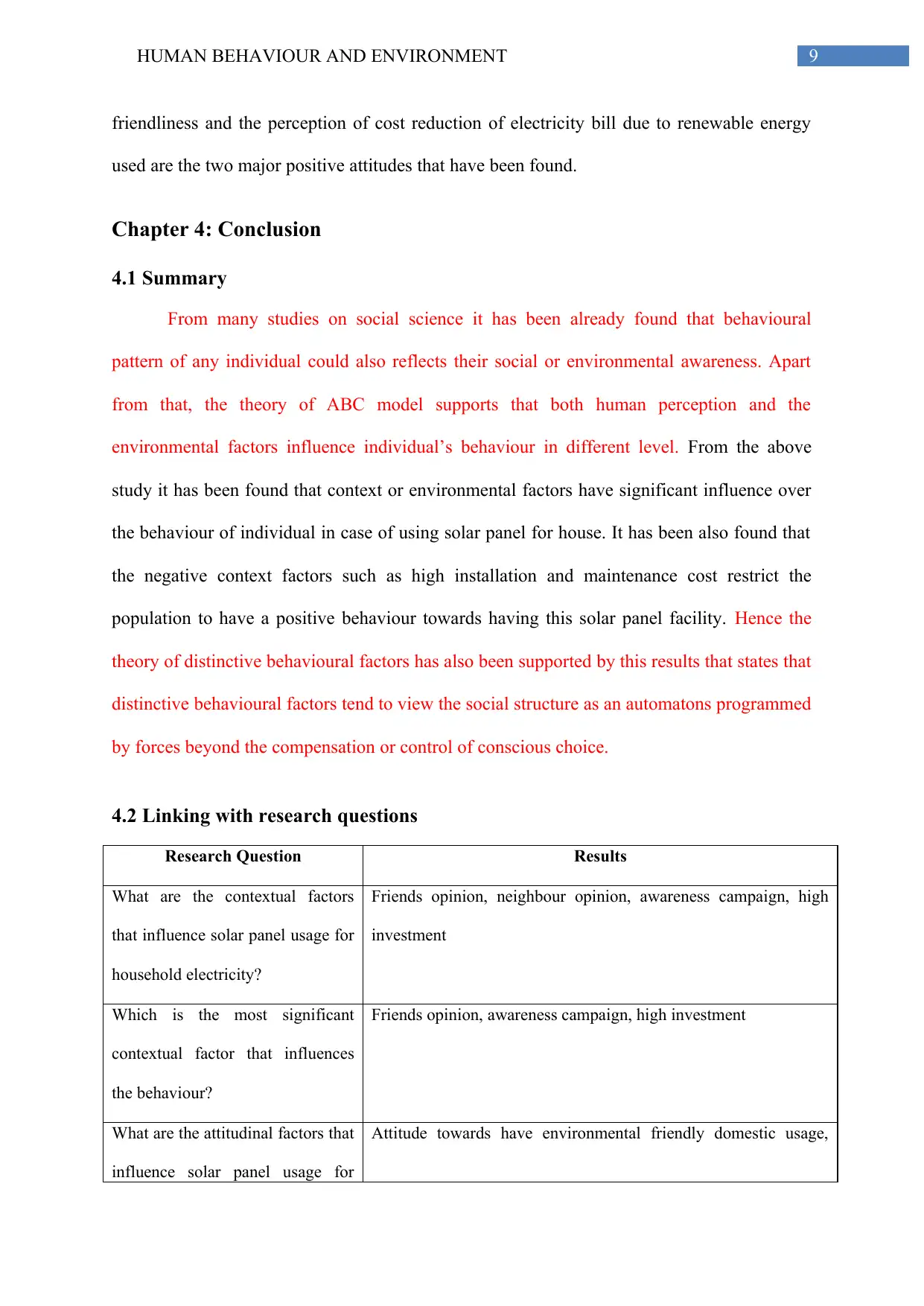
9HUMAN BEHAVIOUR AND ENVIRONMENT
friendliness and the perception of cost reduction of electricity bill due to renewable energy
used are the two major positive attitudes that have been found.
Chapter 4: Conclusion
4.1 Summary
From many studies on social science it has been already found that behavioural
pattern of any individual could also reflects their social or environmental awareness. Apart
from that, the theory of ABC model supports that both human perception and the
environmental factors influence individual’s behaviour in different level. From the above
study it has been found that context or environmental factors have significant influence over
the behaviour of individual in case of using solar panel for house. It has been also found that
the negative context factors such as high installation and maintenance cost restrict the
population to have a positive behaviour towards having this solar panel facility. Hence the
theory of distinctive behavioural factors has also been supported by this results that states that
distinctive behavioural factors tend to view the social structure as an automatons programmed
by forces beyond the compensation or control of conscious choice.
4.2 Linking with research questions
Research Question Results
What are the contextual factors
that influence solar panel usage for
household electricity?
Friends opinion, neighbour opinion, awareness campaign, high
investment
Which is the most significant
contextual factor that influences
the behaviour?
Friends opinion, awareness campaign, high investment
What are the attitudinal factors that
influence solar panel usage for
Attitude towards have environmental friendly domestic usage,
friendliness and the perception of cost reduction of electricity bill due to renewable energy
used are the two major positive attitudes that have been found.
Chapter 4: Conclusion
4.1 Summary
From many studies on social science it has been already found that behavioural
pattern of any individual could also reflects their social or environmental awareness. Apart
from that, the theory of ABC model supports that both human perception and the
environmental factors influence individual’s behaviour in different level. From the above
study it has been found that context or environmental factors have significant influence over
the behaviour of individual in case of using solar panel for house. It has been also found that
the negative context factors such as high installation and maintenance cost restrict the
population to have a positive behaviour towards having this solar panel facility. Hence the
theory of distinctive behavioural factors has also been supported by this results that states that
distinctive behavioural factors tend to view the social structure as an automatons programmed
by forces beyond the compensation or control of conscious choice.
4.2 Linking with research questions
Research Question Results
What are the contextual factors
that influence solar panel usage for
household electricity?
Friends opinion, neighbour opinion, awareness campaign, high
investment
Which is the most significant
contextual factor that influences
the behaviour?
Friends opinion, awareness campaign, high investment
What are the attitudinal factors that
influence solar panel usage for
Attitude towards have environmental friendly domestic usage,
Paraphrase This Document
Need a fresh take? Get an instant paraphrase of this document with our AI Paraphraser
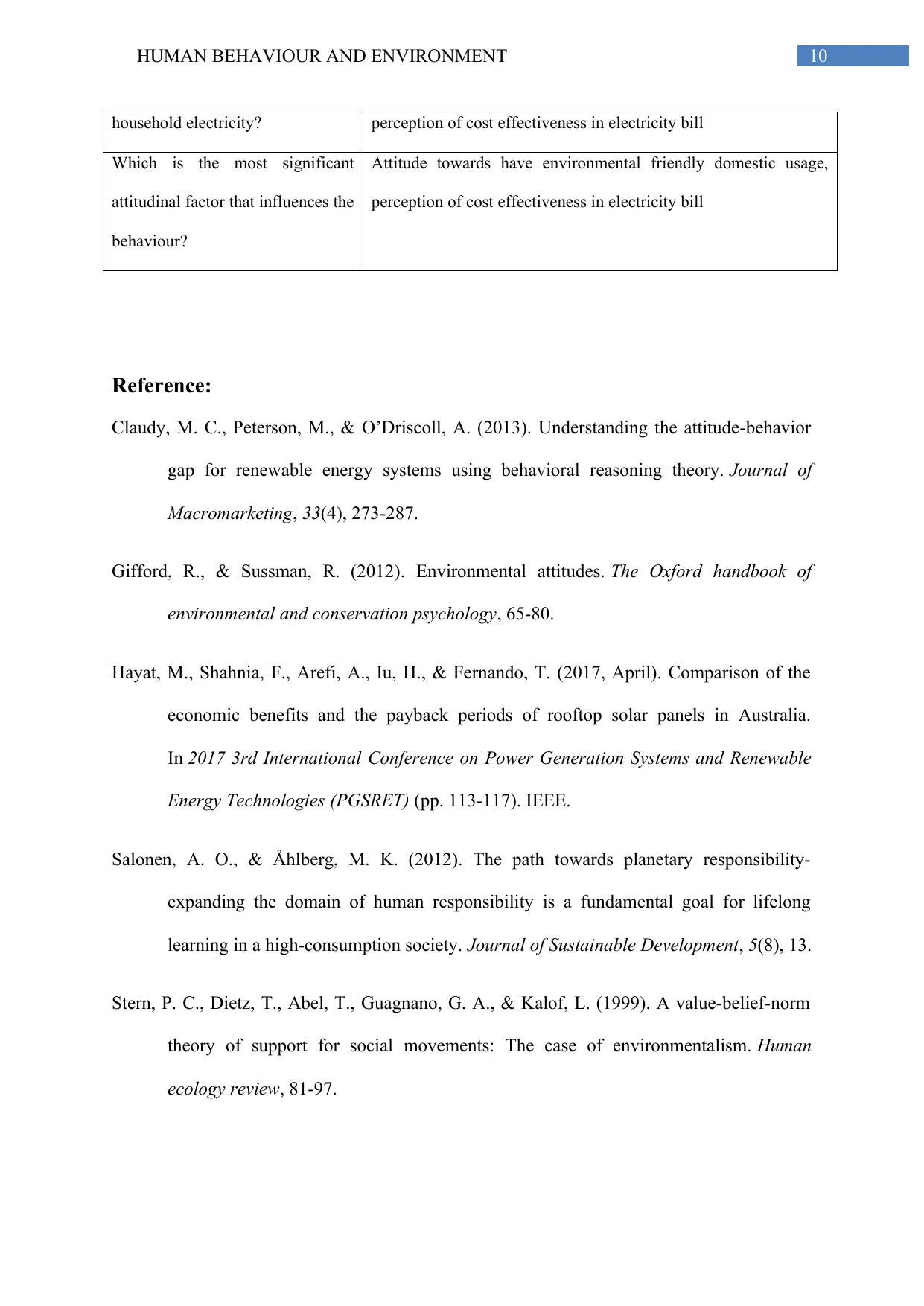
10HUMAN BEHAVIOUR AND ENVIRONMENT
household electricity? perception of cost effectiveness in electricity bill
Which is the most significant
attitudinal factor that influences the
behaviour?
Attitude towards have environmental friendly domestic usage,
perception of cost effectiveness in electricity bill
Reference:
Claudy, M. C., Peterson, M., & O’Driscoll, A. (2013). Understanding the attitude-behavior
gap for renewable energy systems using behavioral reasoning theory. Journal of
Macromarketing, 33(4), 273-287.
Gifford, R., & Sussman, R. (2012). Environmental attitudes. The Oxford handbook of
environmental and conservation psychology, 65-80.
Hayat, M., Shahnia, F., Arefi, A., Iu, H., & Fernando, T. (2017, April). Comparison of the
economic benefits and the payback periods of rooftop solar panels in Australia.
In 2017 3rd International Conference on Power Generation Systems and Renewable
Energy Technologies (PGSRET) (pp. 113-117). IEEE.
Salonen, A. O., & Åhlberg, M. K. (2012). The path towards planetary responsibility-
expanding the domain of human responsibility is a fundamental goal for lifelong
learning in a high-consumption society. Journal of Sustainable Development, 5(8), 13.
Stern, P. C., Dietz, T., Abel, T., Guagnano, G. A., & Kalof, L. (1999). A value-belief-norm
theory of support for social movements: The case of environmentalism. Human
ecology review, 81-97.
household electricity? perception of cost effectiveness in electricity bill
Which is the most significant
attitudinal factor that influences the
behaviour?
Attitude towards have environmental friendly domestic usage,
perception of cost effectiveness in electricity bill
Reference:
Claudy, M. C., Peterson, M., & O’Driscoll, A. (2013). Understanding the attitude-behavior
gap for renewable energy systems using behavioral reasoning theory. Journal of
Macromarketing, 33(4), 273-287.
Gifford, R., & Sussman, R. (2012). Environmental attitudes. The Oxford handbook of
environmental and conservation psychology, 65-80.
Hayat, M., Shahnia, F., Arefi, A., Iu, H., & Fernando, T. (2017, April). Comparison of the
economic benefits and the payback periods of rooftop solar panels in Australia.
In 2017 3rd International Conference on Power Generation Systems and Renewable
Energy Technologies (PGSRET) (pp. 113-117). IEEE.
Salonen, A. O., & Åhlberg, M. K. (2012). The path towards planetary responsibility-
expanding the domain of human responsibility is a fundamental goal for lifelong
learning in a high-consumption society. Journal of Sustainable Development, 5(8), 13.
Stern, P. C., Dietz, T., Abel, T., Guagnano, G. A., & Kalof, L. (1999). A value-belief-norm
theory of support for social movements: The case of environmentalism. Human
ecology review, 81-97.
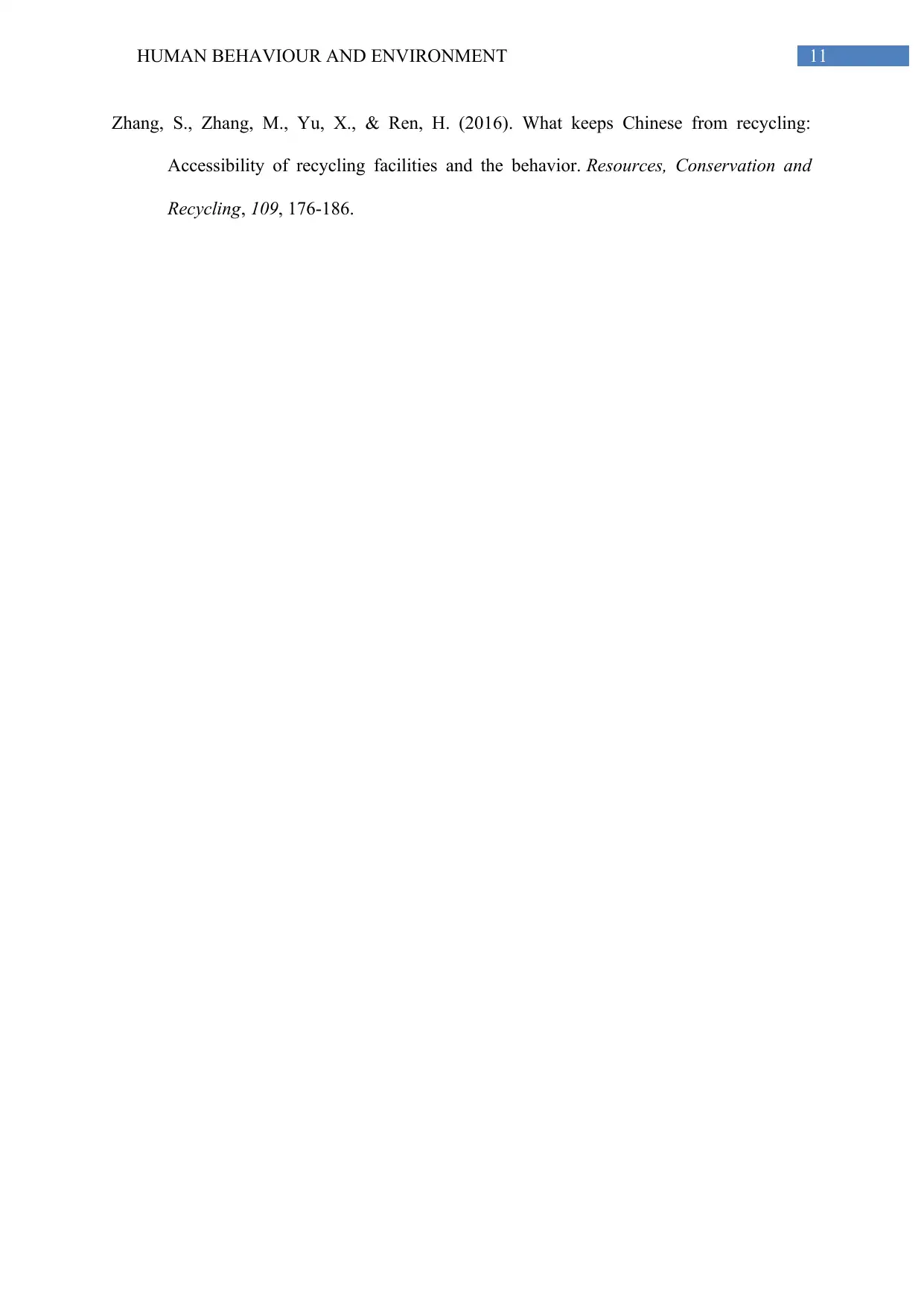
11HUMAN BEHAVIOUR AND ENVIRONMENT
Zhang, S., Zhang, M., Yu, X., & Ren, H. (2016). What keeps Chinese from recycling:
Accessibility of recycling facilities and the behavior. Resources, Conservation and
Recycling, 109, 176-186.
Zhang, S., Zhang, M., Yu, X., & Ren, H. (2016). What keeps Chinese from recycling:
Accessibility of recycling facilities and the behavior. Resources, Conservation and
Recycling, 109, 176-186.
⊘ This is a preview!⊘
Do you want full access?
Subscribe today to unlock all pages.

Trusted by 1+ million students worldwide
1 out of 15
Your All-in-One AI-Powered Toolkit for Academic Success.
+13062052269
info@desklib.com
Available 24*7 on WhatsApp / Email
![[object Object]](/_next/static/media/star-bottom.7253800d.svg)
Unlock your academic potential
Copyright © 2020–2025 A2Z Services. All Rights Reserved. Developed and managed by ZUCOL.